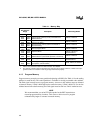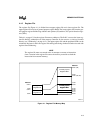
8XC196MC, MD, MH USER’S MANUAL
4-4
4.1.4.3 Security Key
The security key prevents unauthorized programming access to the nonvolatile memory. See
Chapter 16, “Programming the Nonvolatile Memory,” for details.
4.1.4.4 Chip Configuration Bytes (CCBs)
The chip configuration bytes (CCBs) specify the operating environment. They specify the bus
width, bus-control mode, and wait states. They also control powerdown mode, the watchdog tim-
er, and nonvolatile memory protection.
The CCBs are the first bytes fetched from memory when the device leaves the reset state. The
post-reset sequence loads the CCBs into the chip configuration registers (CCRs). Once they are
loaded, the CCRs cannot be changed until the next device reset. Typically, the CCBs are pro-
grammed once when the user program is compiled and are not redefined during normal operation.
“Chip Configuration Registers and Chip Configuration Bytes” on page 15-5 describes the CCBs
and CCRs.
For devices with customer-programmable nonvolatile memory, the CCBs are loaded for normal
operation, but the PCCBs are loaded into the CCRs if the device is entering programming modes.
See Chapter 16, “Programming the Nonvolatile Memory,” for details.
4.1.5 Special-function Registers (SFRs)
These devices have both memory-mapped SFRs and peripheral SFRs. The memory-mapped
SFRs must be accessed using indirect or indexed addressing modes, and they cannot be win-
dowed. The peripheral SFRs are physically located in the on-chip peripherals, and they can be
windowed (see “Windowing” on page 4-12). Do not use reserved SFRs; write zeros to them or
leave them in their default state. When read, reserved bits and reserved SFRs return undefined
values.
NOTE
Using any SFR as a base or index register for indirect or indexed operations
can cause unpredictable results because external events can change the
contents of SFRs. Also, because some SFRs are cleared when read, consider
the implications of using an SFR as an operand in a read-modify-write
instruction (e.g., XORB).


















